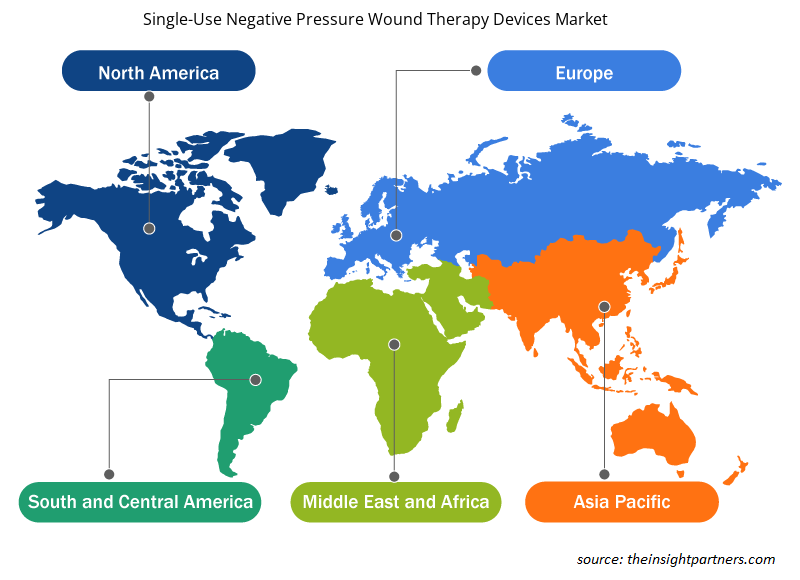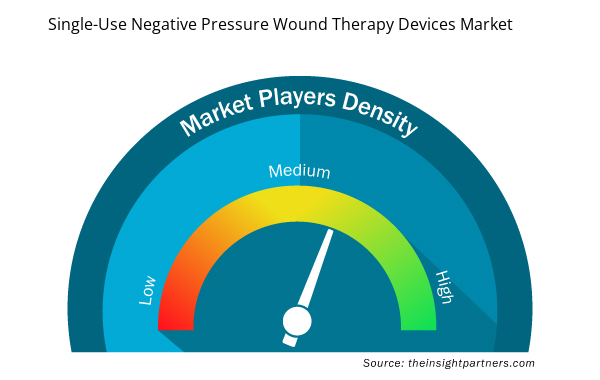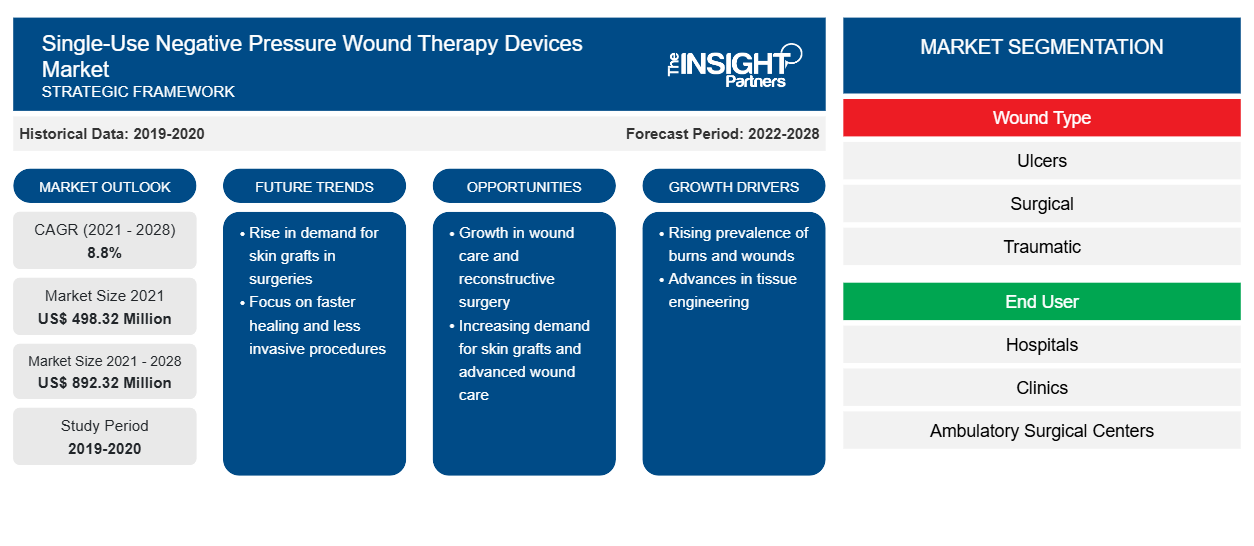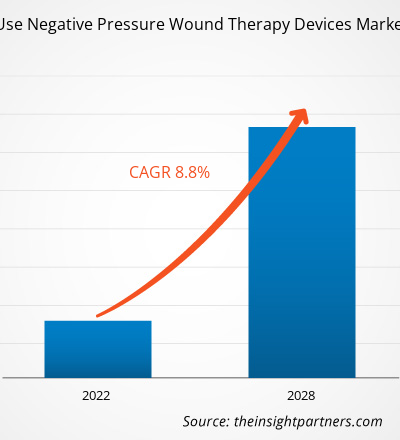Der Markt für Einweggeräte zur Unterdruck-Wundtherapie soll von 498,32 Millionen US-Dollar im Jahr 2021 auf 892,32 Millionen US-Dollar im Jahr 2028 anwachsen; für den Zeitraum von 2021 bis 2028 wird eine durchschnittliche jährliche Wachstumsrate (CAGR) von 8,8 % erwartet.
Die Unterdruck-Wundtherapie ( NPWT ) wird zur Behandlung einer Vielzahl von Wundtypen eingesetzt, darunter traumatische, schwer heilende und chronische Wunden. Sie wird auch zur Behandlung von Wunden eingesetzt, die mit Lappen oder Hauttransplantaten abgedeckt sind. Diese Therapie wird in ein medizinisches Gerät wie ein Einweg- NPWT -Gerät umgesetzt, ein kleines batteriebetriebenes Gerät im Taschenformat. Wie der Name schon sagt, handelt es sich dabei um tragbare Einweggeräte, die im Allgemeinen für die ambulante Behandlung verwendet werden.
Der Bericht bietet Einblicke und eine eingehende Analyse des Marktes für Einweg-Unterdruck-Wundtherapiegeräte und legt dabei den Schwerpunkt auf verschiedene Parameter wie Markttrends, technologische Fortschritte, Marktdynamik und Wettbewerbslandschaftsanalysen führender Marktteilnehmer auf der ganzen Welt. Er umfasst auch die Auswirkungen der COVID-19-Pandemie auf den Markt in allen Regionen. Der Markt für Einweg-Unterdruck-Wundtherapiegeräte verzeichnete zu Beginn der COVID-19-Krise einen Engpass aufgrund von Störungen in der Lieferkette und einen Nachfrageeinbruch aufgrund der von den meisten Ländern weltweit angekündigten Ausgangssperre , die zu Störungen in der Produktion und im Betrieb des Pharmasektors führte. Darüber hinaus sind die Dienstleistungen für die Versorgung chronischer Wunden im ersten und zweiten Quartal 2020 drastisch zurückgegangen, haben sich jedoch Ende 2020 normalisiert. Darüber hinaus bevorzugen die Menschen Einweggeräte, um Kreuzkontaminationen durch Geräte zu reduzieren. Die zunehmende Verwendung von Einweg- NPWT- Geräten (Einmalgebrauch) treibt deren Nachfrage auf dem globalen Markt für Einweg-Unterdruck-Wundtherapiegeräte an. Darüber hinaus gab es einen deutlichen Rückgang der stationären und ambulanten Patienten bei privaten Krankenhausketten. Um die Gesundheitssysteme zu entlasten, haben viele Kliniken Diagnosen und Behandlungen außer bei COVID-19 verschoben. In Indien beispielsweise wurde das staatliche Victoria Hospital, das dem Bangalore Medical College and Research Institute ( BMCRI ) angeschlossen ist, in eine spezielle COVID-19-Einrichtung umgewandelt, seit die Pandemie im März Karnataka erreichte . Der Betrieb der Mahabodhi Burns Ward im Krankenhaus wurde davon nicht beeinträchtigt. Trotz der Pandemie setzte das Krankenhaus seinen normalen Betrieb unter Einhaltung aller COVID-19-Vorsichtsmaßnahmen fort.
Passen Sie diesen Bericht Ihren Anforderungen an
Sie erhalten kostenlose Anpassungen an jedem Bericht, einschließlich Teilen dieses Berichts oder einer Analyse auf Länderebene, eines Excel-Datenpakets sowie tolle Angebote und Rabatte für Start-ups und Universitäten.
- Holen Sie sich die wichtigsten Markttrends aus diesem Bericht.Dieses KOSTENLOSE Beispiel umfasst eine Datenanalyse von Markttrends bis hin zu Schätzungen und Prognosen.
Die Behandlung chronischer Wunden während der Pandemie war für beide Seiten – Patienten und Ärzte – eine sehr schwierige Aufgabe. Um das Expositionsrisiko während der Pandemie zu minimieren, verwendeten die Patienten Einweggeräte anstelle herkömmlicher NPWT- Geräte. Aus gesundheitlichen Gründen bevorzugten die Menschen Einwegprodukte zur Behandlung chronischer und akuter Wunden. Dieser Faktor unterstützte das Wachstum des Marktes während der Pandemie. Der Markt für Einweggeräte zur Unterdruck-Wundtherapie ist nach Wundtyp, Endverbraucher und Geografie segmentiert. Der Markt ist nach Regionen in Nordamerika, Europa, Asien-Pazifik, den Nahen Osten und Afrika sowie Süd- und Mittelamerika unterteilt.
Markteinblicke
Zunahme bei Verbrennungsfällen
Im Jahr 2019 wurden weltweit insgesamt 8.378.122 neue Fälle von Verbrennungen festgestellt. In vielen Ländern mit hohem Einkommen ist die Sterberate durch Verbrennungen rückläufig, doch in Ländern mit niedrigem und mittlerem Einkommen liegt die Sterberate von Kindern durch Verbrennungen inzwischen etwa siebenmal höher als in Ländern mit hohem Einkommen. Das Unterdruck-Wundtherapiesystem zum Einmalgebrauch wird zur Behandlung akuter und chronischer Wunden sowie geschlossener chirurgischer Schnitte mit geringer bis mäßiger Exsudatmenge verwendet . Bei der Unterdruck-Wundtherapie ( NPWT ) wird Unterdruck (Vakuum) auf eine Wunde ausgeübt, um sie zu versorgen und die Heilung zu fördern. Weitere Bezeichnungen für NPWT sind topische Unterdrucktherapie ( TNP ), vakuumgestützter Wundverschluss (VAC) und versiegelte Wundabsaugung an der Oberfläche . Die NPWT wird verwendet, um bei Brandverletzten überschüssige Flüssigkeit abzulassen und die lokale Durchblutung zu verbessern. Es wird vermutet, dass die Wirkung der NPWT zu einer erhöhten Sauerstoff- und Nährstoffzufuhr zur Verbrennung führen und so die Heilung fördern kann. Das Einmal-Unterdruck-Wundtherapiesystem ist für Personen gedacht, die von einem Absauggerät (Unterdruck-Wundtherapie) profitieren würden, da es die Wundheilung fördert, indem es geringe bis mittlere Mengen Exsudat und infektiöse Rückstände entfernt. Beispiele für akzeptable Wundtypen sind chronische, akute, traumatische, subakute und klaffende Wunden, Verbrennungen zweiten Grades, Geschwüre (z. B. diabetische oder Druckgeschwüre), Lappen und Transplantate sowie geschlossene chirurgische Schnitte.
Darüber hinaus werden nach Angaben des Children's Burn Trust und der British Burn Association jeden Monat 625 Kinder wegen Verbrennungen oder Verbrühungen in die Verbrennungsstation des NHS eingeliefert. Im Jahr 2017 behandelten die Verbrennungs- und Verbrühungsstationen des NHS über 15.000 Patienten mit derartigen Verletzungen, wobei Gesamtkosten von über 24,94 Millionen US-Dollar ( d. h . 20 Millionen GBP ) entstanden. Über 40 aller Verbrennungsbehandlungen im Jahr 2017 wurden als extrem schwerwiegend eingestuft, wobei die Behandlungskosten über 118.455,50 US-Dollar ( 95.000 GBP ) pro Person betrugen. In Entwicklungsregionen wie dem Asien-Pazifik-Raum, Afrika und dem Nahen Osten nehmen Verbrennungen durch Haushalts- und Industrieunfälle zu. Der Markt für Einweg-Wundpflegegeräte mit Unterdruck wird daher durch die steigende Zahl von Verbrennungen und ähnlichen Verletzungen angetrieben.
Erkenntnisse basierend auf Wundtypen
Der globale Markt für Einweg-Unterdruck-Wundtherapiegeräte wurde nach Wundtyp in Geschwüre, chirurgische Wunden, traumatische Wunden, Sportverletzungen, Lappen und Transplantate sowie Verbrennungen unterteilt. Im Jahr 2022 hatte das traumatische Segment den größten Marktanteil; es wird erwartet, dass es seine Dominanz im Prognosezeitraum beibehält. Diese Art von Wunde ist aufgrund der zunehmenden Häufigkeit von Verkehrsunfällen und Traumafällen am häufigsten. Darüber hinaus wird erwartet, dass das traumatische Segment im Zeitraum 2021–2028 die höchste durchschnittliche jährliche Wachstumsrate verzeichnet.
Endbenutzerbasierte Erkenntnisse
Basierend auf dem Endverbraucher wurde der Markt für Einweg-Unterdruck-Wundtherapiegeräte in Krankenhäuser, Kliniken, ambulante chirurgische Zentren und andere unterteilt. Das Krankenhaussegment hielt im Jahr 2022 den größten Marktanteil und wird im Prognosezeitraum voraussichtlich die höchste durchschnittliche jährliche Wachstumsrate verzeichnen.
Die Marktteilnehmer für Einweggeräte zur Unterdruck-Wundtherapie verfolgen organische Strategien wie Produkteinführung und -erweiterung, um ihre Präsenz und ihr Produktportfolio weltweit zu erweitern und die steigende Nachfrage zu decken.
Geographiebasierte Erkenntnisse
Geografisch ist der Markt für Einweggeräte zur Unterdruck-Wundtherapie segmentiert in Nordamerika (USA, Kanada und Mexiko), Europa (Frankreich, Deutschland, Großbritannien, Spanien, Italien und das übrige Europa), Asien-Pazifik (China, Indien, Japan, Australien, Südkorea und der restliche Asien-Pazifik-Raum ), Naher Osten und Afrika (Saudi-Arabien, die Vereinigten Arabischen Emirate , Südafrika und der restliche Nahe Osten und Afrika ) sowie Süd- und Mittelamerika (Brasilien, Argentinien und der restliche Süd- und Mittelamerika).
Regionale Einblicke in den Markt für Einweg-Unterdruck-Wundtherapiegeräte
Die regionalen Trends und Faktoren, die den Markt für Einweg-Unterdruck-Wundtherapiegeräte während des gesamten Prognosezeitraums beeinflussen, wurden von den Analysten von Insight Partners ausführlich erläutert. In diesem Abschnitt werden auch die Marktsegmente und die Geografie von Einweg-Unterdruck-Wundtherapiegeräten in Nordamerika, Europa, im asiatisch-pazifischen Raum, im Nahen Osten und Afrika sowie in Süd- und Mittelamerika erörtert.

- Erhalten Sie regionale Daten zum Markt für Einweg-Unterdruck-Wundtherapiegeräte
Umfang des Marktberichts zu Geräten zur Einmal-Unterdruck-Wundtherapie
| Berichtsattribut | Details |
|---|---|
| Marktgröße im Jahr 2021 | 498,32 Millionen US-Dollar |
| Marktgröße bis 2028 | 892,32 Millionen US-Dollar |
| Globale CAGR (2021 - 2028) | 8,8 % |
| Historische Daten | 2019-2020 |
| Prognosezeitraum | 2022–2028 |
| Abgedeckte Segmente | Nach Wundtyp
|
| Abgedeckte Regionen und Länder | Nordamerika
|
| Marktführer und wichtige Unternehmensprofile |
|
Marktteilnehmerdichte bei Einweg-Unterdruck-Wundtherapiegeräten: Auswirkungen auf die Geschäftsdynamik verstehen
Der Markt für Einweg-Unterdruck-Wundtherapiegeräte wächst rasant, angetrieben von der steigenden Nachfrage der Endnutzer aufgrund von Faktoren wie sich entwickelnden Verbraucherpräferenzen, technologischen Fortschritten und einem größeren Bewusstsein für die Vorteile des Produkts. Mit steigender Nachfrage erweitern Unternehmen ihr Angebot, entwickeln Innovationen, um die Bedürfnisse der Verbraucher zu erfüllen, und nutzen neue Trends, was das Marktwachstum weiter ankurbelt.
Die Marktteilnehmerdichte bezieht sich auf die Verteilung der Firmen oder Unternehmen, die in einem bestimmten Markt oder einer bestimmten Branche tätig sind. Sie gibt an, wie viele Wettbewerber (Marktteilnehmer) in einem bestimmten Marktraum im Verhältnis zu seiner Größe oder seinem gesamten Marktwert präsent sind.
Die wichtigsten Unternehmen auf dem Markt für Einweg-Unterdruck-Wundtherapiegeräte sind:
- Cardinal Health Inc
- ConvaTec Group Plc
- Carilex Medizin
- Genadyne Biotechnologies, Inc.
- H und R Gesundheitswesen
Haftungsausschluss : Die oben aufgeführten Unternehmen sind nicht in einer bestimmten Reihenfolge aufgeführt.

- Überblick über die wichtigsten Akteure auf dem Markt für Einweg-Unterdruck-Wundtherapiegeräte
Unternehmensbasierte Einblicke
Cardinal Health Inc; ConvaTec Group Plc; Carilex Medical; Genadyne Biotechnologies, Inc.; H and R Healthcare; Lohmann & Rauscher GmbH & Co. KG; Medela AG; Mölnlycke Health Care AB; Paul Hartmann Ag; und Smith & Nephew plc gehören zu den führenden Unternehmen auf dem Markt für Einweggeräte zur Unterdruck-Wundtherapie.
- Historische Analyse (2 Jahre), Basisjahr, Prognose (7 Jahre) mit CAGR
- PEST- und SWOT-Analyse
- Marktgröße Wert/Volumen – Global, Regional, Land
- Branche und Wettbewerbsumfeld
- Excel-Datensatz



Report Coverage
Revenue forecast, Company Analysis, Industry landscape, Growth factors, and Trends

Segment Covered
This text is related
to segments covered.

Regional Scope
North America, Europe, Asia Pacific, Middle East & Africa, South & Central America

Country Scope
This text is related
to country scope.
Häufig gestellte Fragen
Global single-use negative pressure wound therapy devices market is segmented by region into North America, Europe, Asia Pacific, Middle East & Africa, and South & Central America. In North America, the U.S. is the largest market for single-use negative pressure wound therapy devices market. The presence of top players and favorable regulations related to product approvals coupled with commercialization of new products are the contributing factors to the regional growth. Additionally, the increasing number of technological advancements, the high adoption rate of devices, and increasing prevalence of wounds are the key factor responsible for the Asia-Pacific regional growth for single-use negative pressure wound therapy devices accounting fastest growth of the region during the coming years.
Cardinal Health Inc; ConvaTec Group Plc; Carilex Medical; Genadyne Biotechnologies, Inc.; H and R Healthcare; Lohmann & Rauscher GmbH & Co. KG; Medela AG; Mölnlycke Health Care AB; Paul Hartmann Ag, and Smith & Nephew plc are among the leading companies operating in the global single-use negative pressure wound therapy devices market
The hospital segment dominated the global single-use negative pressure wound therapy devices market and accounted for the largest revenue of 166.73 million in 2021.
Based on wound type, traumatic segment took the forefront leaders in the worldwide market by accounting largest share in 2022 and is expected to continue to do so till the forecast period.
The increasing prevalence of wounds owing to a surge in trauma, burns, and various conditions such as diabetes and others along with the increase in surgeries are the most significant factors responsible for the overall market growth.
Negative pressure wound therapy (NPWT) is used for managing wide range of wound types such as traumatic, hard-to-heal, and chronic wounds. It is also used to manage wounds that are covered with flaps or a skin graft. This therapy is transformed into a medical device such as a single-use NPWT device, and it is a small pocket-sized battery-operated device. As the name suggests, these are disposable and portable devices generally used for outpatient care.
Trends and growth analysis reports related to Life Sciences : READ MORE..
The List of Companies - Single-Use Negative Pressure Wound Therapy Devices Market
- Cardinal Health Inc
- ConvaTec Group Plc
- Carilex Medical
- Genadyne Biotechnologies, Inc.
- H and R Healthcare
- Lohmann & Rauscher GmbH & Co. KG
- Medela AG
- Mölnlycke Health Care AB
- Paul Hartmann Ag
- Smith & Nephew plc
The Insight Partners performs research in 4 major stages: Data Collection & Secondary Research, Primary Research, Data Analysis and Data Triangulation & Final Review.
- Data Collection and Secondary Research:
As a market research and consulting firm operating from a decade, we have published and advised several client across the globe. First step for any study will start with an assessment of currently available data and insights from existing reports. Further, historical and current market information is collected from Investor Presentations, Annual Reports, SEC Filings, etc., and other information related to company’s performance and market positioning are gathered from Paid Databases (Factiva, Hoovers, and Reuters) and various other publications available in public domain.
Several associations trade associates, technical forums, institutes, societies and organization are accessed to gain technical as well as market related insights through their publications such as research papers, blogs and press releases related to the studies are referred to get cues about the market. Further, white papers, journals, magazines, and other news articles published in last 3 years are scrutinized and analyzed to understand the current market trends.
- Primary Research:
The primarily interview analysis comprise of data obtained from industry participants interview and answers to survey questions gathered by in-house primary team.
For primary research, interviews are conducted with industry experts/CEOs/Marketing Managers/VPs/Subject Matter Experts from both demand and supply side to get a 360-degree view of the market. The primary team conducts several interviews based on the complexity of the markets to understand the various market trends and dynamics which makes research more credible and precise.
A typical research interview fulfils the following functions:
- Provides first-hand information on the market size, market trends, growth trends, competitive landscape, and outlook
- Validates and strengthens in-house secondary research findings
- Develops the analysis team’s expertise and market understanding
Primary research involves email interactions and telephone interviews for each market, category, segment, and sub-segment across geographies. The participants who typically take part in such a process include, but are not limited to:
- Industry participants: VPs, business development managers, market intelligence managers and national sales managers
- Outside experts: Valuation experts, research analysts and key opinion leaders specializing in the electronics and semiconductor industry.
Below is the breakup of our primary respondents by company, designation, and region:

Once we receive the confirmation from primary research sources or primary respondents, we finalize the base year market estimation and forecast the data as per the macroeconomic and microeconomic factors assessed during data collection.
- Data Analysis:
Once data is validated through both secondary as well as primary respondents, we finalize the market estimations by hypothesis formulation and factor analysis at regional and country level.
- Macro-Economic Factor Analysis:
We analyse macroeconomic indicators such the gross domestic product (GDP), increase in the demand for goods and services across industries, technological advancement, regional economic growth, governmental policies, the influence of COVID-19, PEST analysis, and other aspects. This analysis aids in setting benchmarks for various nations/regions and approximating market splits. Additionally, the general trend of the aforementioned components aid in determining the market's development possibilities.
- Country Level Data:
Various factors that are especially aligned to the country are taken into account to determine the market size for a certain area and country, including the presence of vendors, such as headquarters and offices, the country's GDP, demand patterns, and industry growth. To comprehend the market dynamics for the nation, a number of growth variables, inhibitors, application areas, and current market trends are researched. The aforementioned elements aid in determining the country's overall market's growth potential.
- Company Profile:
The “Table of Contents” is formulated by listing and analyzing more than 25 - 30 companies operating in the market ecosystem across geographies. However, we profile only 10 companies as a standard practice in our syndicate reports. These 10 companies comprise leading, emerging, and regional players. Nonetheless, our analysis is not restricted to the 10 listed companies, we also analyze other companies present in the market to develop a holistic view and understand the prevailing trends. The “Company Profiles” section in the report covers key facts, business description, products & services, financial information, SWOT analysis, and key developments. The financial information presented is extracted from the annual reports and official documents of the publicly listed companies. Upon collecting the information for the sections of respective companies, we verify them via various primary sources and then compile the data in respective company profiles. The company level information helps us in deriving the base number as well as in forecasting the market size.
- Developing Base Number:
Aggregation of sales statistics (2020-2022) and macro-economic factor, and other secondary and primary research insights are utilized to arrive at base number and related market shares for 2022. The data gaps are identified in this step and relevant market data is analyzed, collected from paid primary interviews or databases. On finalizing the base year market size, forecasts are developed on the basis of macro-economic, industry and market growth factors and company level analysis.
- Data Triangulation and Final Review:
The market findings and base year market size calculations are validated from supply as well as demand side. Demand side validations are based on macro-economic factor analysis and benchmarks for respective regions and countries. In case of supply side validations, revenues of major companies are estimated (in case not available) based on industry benchmark, approximate number of employees, product portfolio, and primary interviews revenues are gathered. Further revenue from target product/service segment is assessed to avoid overshooting of market statistics. In case of heavy deviations between supply and demand side values, all thes steps are repeated to achieve synchronization.
We follow an iterative model, wherein we share our research findings with Subject Matter Experts (SME’s) and Key Opinion Leaders (KOLs) until consensus view of the market is not formulated – this model negates any drastic deviation in the opinions of experts. Only validated and universally acceptable research findings are quoted in our reports.
We have important check points that we use to validate our research findings – which we call – data triangulation, where we validate the information, we generate from secondary sources with primary interviews and then we re-validate with our internal data bases and Subject matter experts. This comprehensive model enables us to deliver high quality, reliable data in shortest possible time.


 Holen Sie sich ein kostenloses Muster für diesen Bericht
Holen Sie sich ein kostenloses Muster für diesen Bericht